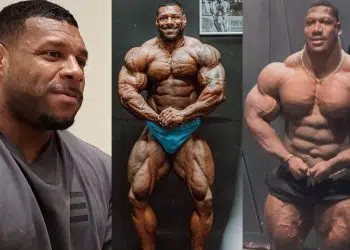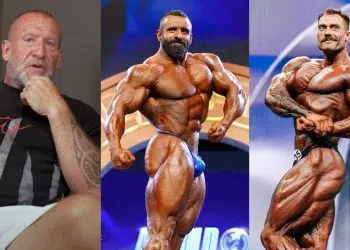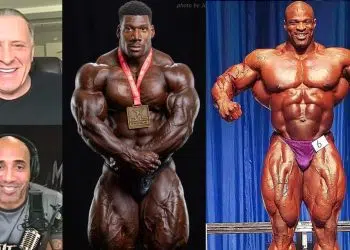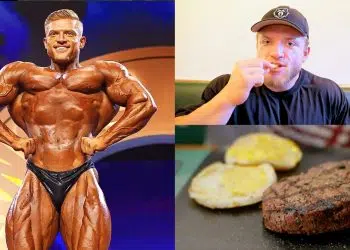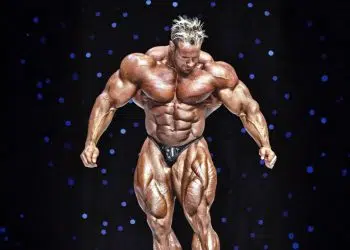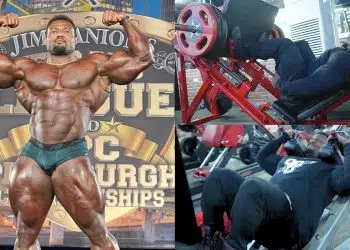Fitness expert Jeff Nippard routinely shares lesser-known scientific facts to help fitness enthusiasts achieve their goals in a more sustainable way. Recently, he made a detailed breakdown of long-length partial reps.
Jeff Nippard is a foremost name in the science-based YouTube fitness community. The Canadian fitness expert is a natural bodybuilder as well as powerlifter himself and has several accolades to his name. He became the 2012 Junior Mr. Canada and also held the Canadian national record for bench press.
Over the years, Jeff Nippard has trained several natural bodybuilders and powerlifters to achieve their goals. He reached a larger audience through evidence-backed bodybuilding content with a scientific approach. At the time of this article’s publishing, Nippard has a staggering 3.98 million subscribers to his YouTube channel.
Nippard has dedicated a lot of time in recent months to explore the techniques that can increase the efficiency of an average person’s fitness journey. He has done extensive research on minimalist training philosophy and shared a training plan based on its principles. Apart from this, the 32-year-old has delved into topics like sustainable weight management methods as well as impact of PEDs and possible risks associated with them.
Increasing the training intensity and getting the maximum amount of returns for the time and energy invested in training is fast becoming a topic of interest. Methods like drop sets, supersets, rest-pause and others have proven benefits in increasing training intensity. However, long-length partial reps is a technique that is rapidly gaining popularity.
In a recent video posted on his YouTube channel, Nippard explained the benefits and methods of incorporating long-length partials in training programs.
Level Up Your Fitness: Join our 💪 strong community in Fitness Volt Newsletter. Get daily inspiration, expert-backed workouts, nutrition tips, the latest in strength sports, and the support you need to reach your goals. Subscribe for free!
Jeff Nippard advices to incorporate long-length partials in training routine
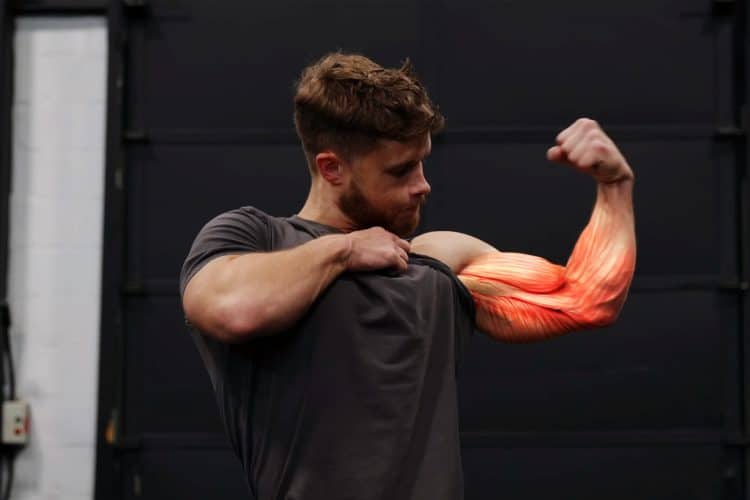
For the uninitiated, long-length partials are partial reps performed with target muscles in lengthened position. For example, partial biceps curls performed from the starting position to a little past the mid-way point qualify as long-length partials. This is because the bicep muscles are in the lengthened position in the beginning of the rep.
“So to figure out if a muscle is at a long length or not, just think about which half of the range of motion stretches the muscle the most and that’s the half you want.”
Nippard stated that long-length partials are more effective for increasing the training intensity than most other techniques like drop sets, supersets or even rest-pause. He argued that this technique might even be more effective than the standard full range of motion.
“A growing pile of research has shown that it is, in fact, the stretched part of the range that triggers the most muscle growth and not full range of motion, per se!”
Nippard backed his claims with studies that compared the effectiveness of full range, long-length and short length partials. An overwhelmingly large majority of these studies concluded that long-length partials were superior options to achieve muscle growth.
“It also shouldn’t be super surprising that training in the stretched aspect of a lift is good for muscle growth. For years, we’ve had a pretty good idea that stretch-mediated hypertrophy is a thing!”
All that being said, how will you incorporate long length partials into your training to maximize muscle hypertrophy? Jeff Nippard answers!
Long-Length Partial Method #1
To increase the training intensity, Nippard uses the technique to extend beyond failure. He uses this technique primarily for the back and hamstrings exercises.
“That’s because on pretty much every back exercise, you’ll reach a point where you can’t get the weight all the way down. But you can still crank out another five or six partial reps in the top half, if you really went for it.”
Once Nippard reaches a point where he can’t pull the weight all the way down to achieve full contraction, he performs as many long-length partials as he can. Naturally, this happens towards the end of the final set.
“You could also do these on your last set of pull-ups. So once you can no longer touch your chest to the bar, keep going with long-length partials on your last set. Same thing goes for rows. Once you can no longer get that full squeeze, keep going in the stretched part until you can no longer get the weight about half way up.”
Nippard follows a similar technique for hamstrings exercises as well.
“The most important thing is standardizing the range of motion so that you pick the same endpoint from week to week. That way, you can be consistent with tracking your progress.”
Anything and everything, when done in excess can be detrimental to your progress and overall health. Jeff Nippard feels the same about overusing long-length partials in training routine. He explained:
“And again, I’m not doing this level of intensity for every set of every exercise. If you were to do that, you’d most likely see a dramatic fall off in your performance toward the end of the workout and your volume will most likely take a hit as a result. You can also run into recovery issues, especially if your diet and sleep aren’t optimized.”
So, be mindful when you try to incorporate this technique in your training routine!
View this post on InstagramGet Fitter, FasterLevel Up Your Fitness: Join our 💪 strong community in Fitness Volt Newsletter. Get daily inspiration, expert-backed workouts, nutrition tips, the latest in strength sports, and the support you need to reach your goals. Subscribe for free!
Long-Length Partial Method #2
The second way to incorporate this training method is to perform a full set of long-length partials. Naturally, you have to use slightly heavier weights to do a full set of long-length partials.
“This is how Dr. Milo Wolf recommended that I do them since you get to spend more total time in the most anabolic part of the range of motion. ‘Why water the set down with time spent in the less anabolic part of the range?’ This is what he said.”
Nippard elaborated further on this method. He stated that in the week one of his training program, he performed the last set of chest supported rows with long-length partials with the goal to hit failure on the tenth rep in the set.
“It also makes a lot of sense to do long-length partials on dumbbell flyes. That’s because with dumbbell flyes, you already have this very lopsided resistance curve where there is tons of tension in the bottom and virtually zero tension at the top. But, maybe that’s not such a bad thing. Because we now know that the lengthened part of the range is the most important part and dumbbell flyes naturally emphasize the lengthened part.”
Whenever Jeff Nippard performs dumbbell chest flyes, he performs them with lengthened partials. However, it is a different story with cable chest flyes. Cable machines put the muscles under tension throughout the range of motion. Therefore a full range of motion is a better option with them.
Jeff Nippard has been experimenting with this technique of long-length partials for leg press and Smith machine chest press as well.
“It’s not that the long-length partials are easier. If anything, I’d say they’re harder because you don’t get that tiny, mini rest at full lockout. But I still think they’re super fun.”
Long-Length Partial Method #3
You son’t have to do a full set of long-length partials. You also don’t need to do them towards the end to push beyond failure. Instead, you can sprinkle them throughout the set and make the set more interesting. Nippard explained:
“I’ve been doing these on pec deck flyes where I’ll alternate full range of motion reps with long-length partial reps. I think they’re a solid option because they allow you to spend more total time in the most anabolic part of the range of motion without completely emitting the contracted part. I also think that they keep the set more engaging and cause a crazy pump.”
Common mistakes to avoid with long-length partial reps
Just like any other technique, partial reps would not be useful if you don’t perform them in the correct manner. After explaining the methods of incorporating long-length partials in the workouts, Jeff Nippard shed light on common mistakes to avoid.
#1. Use proper technique
To a lot of people, partial reps are cheat reps that do not require a strict adherence to form. However, Jeff Nippard advises to avoid this mistake while incorporating partial reps in the workout.
“Partial rep should still be treated like any other rep. Meaning, you still control the negative, you still minimize the momentum and you still feel that deep stretch at the bottom.”
#2. Limit the range of motion
As the name suggests, partials are supposed to be performed within a limited range of motion. However, Nippard observes that a lot of people do not limit the range of motion enough.
“People like myself who are accustomed to using a full range of motion are really often shy to cut their range of motion short and end up skipping just the lockout. So they’re still actually doing 90 percent of the full range of motion.”
Therefore, do not be afraid to cut the range of motion to perform a real long-length partial.
#3. Do not Overhype the long-length partials
No matter how effective and potent a workout technique is, it will not have any miraculous effect on your overall growth. It can optimize it and help you make better gains. But it will not bring any miraculous transformation.
“I don’t think there is enough evidence to completely throw out all exercises that work with a more shortened position – especially if it is an exercise that we’ve been doing for decades with good results.”
Nippard also clarified that there is no conclusive evidence which suggests that cutting out the top half of reps is the best practice for all the exercises.
“If you zoom out and look at the picture as a whole, long-length partials really aren’t miles ahead. I think that at this point, the best you can say is that long-length partials clearly work better than the short-length partials. And, at least work as well as full range of motion and maybe even better in some cases.”
There is a lot of hype around long-length partials in the online fitness community. But as Jeff Nippard explained, it is a technique that is more effective in certain cases. It will not bring any miraculous transformation. But it will certainly help you increase the intensity and efficiency of the training routine.
Watch the full video below, courtesy of Jeff Nippard’s personal YouTube channel:



